Evolution of automobiles
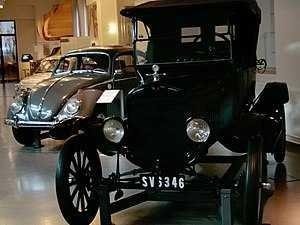
The early history of the automobile can be divided into a number of eras, based on the prevalent means of propulsion. Later periods were defined by trends in exterior styling, size, and utility preferences.
In 1769 the first steam-powered automobile capable of human transportation was built by Nicolas-Joseph Cugnot.
In 1808, François Isaac de Rivaz designed the first car powered by an internal combustion engine fueled by hydrogen.
In 1870 Siegfried Marcus built the first gasoline powered combustion engine, which he placed on a pushcart, building four progressively sophisticated combustion-engine cars over a 10-to-15-year span that influenced later cars. Marcus created the two-cycle combustion engine. The car's second incarnation in 1880 introduced a four-cycle, gasoline-powered engine, an ingenious carburetor design and magneto ignition. He created an additional two models further refining his design with steering, a clutch and a brake.
The four-stroke petrol (gasoline) internal combustion engine that still constitutes the most prevalent form of modern automotive propulsion was patented by Nikolaus Otto. The similar four-stroke diesel engine was invented by Rudolf Diesel. The hydrogen fuel cell, one of the technologies hailed as a replacement for gasoline as an energy source for cars, was discovered in principle by Christian Friedrich Schönbein in 1838. The battery electric car owes its beginnings to Ányos Jedlik, one of the inventors of the electric motor, and Gaston Planté, who invented the lead–acid battery in 1859.
In 1885, Karl Benz developed a petrol or gasoline powered automobile. This is also considered to be the first "production" vehicle as Benz made several other identical copies. The automobile was powered by a single cylinder four-stroke engine.
In 1913, the Ford Model T, created by the Ford Motor Company five years prior, became the first automobile to be mass-produced on a moving assembly line. By 1927, Ford had produced over 15,000,000 Model T automobiles.
At the turn of the 20th century electrically powered automobiles became a popular alternative method of automobile propulsion.
** Power sources **
The early history of the automobile was concentrated on the search for a reliable portable power unit to propel the vehicle.
** Steam-powered wheeled vehicles **
** 17th and 18th centuries **
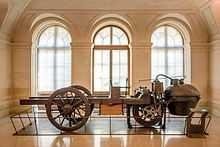
Cugnot's steam wagon, the second (1771) version.
Ferdinand Verbiest, a member of a Jesuit mission in China, built a steam-powered vehicle around 1672 as a toy for the Chinese Emperor. It was small scale and could not carry a driver but it was, quite possibly, the first working steam-powered vehicle ('auto-mobile').
Steam-powered self-propelled vehicles large enough to transport people and cargo were first devised in the late 18th century. Nicolas-Joseph Cugnot demonstrated his fardier à vapeur ("steam dray"), an experimental steam-driven artillery tractor, in 1770 and 1771. As Cugnot's design proved to be impractical, his invention was not developed in his native France. The center of innovation shifted to Great Britain. By 1784, William Murdoch had built a working model of a steam carriage in Redruth and in 1801 Richard Trevithick was running a full-sized vehicle on the roads in Camborne. The first automobile patent in the United States was granted to Oliver Evans in 1789.
** 19th century **
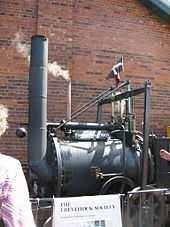
A replica of Richard Trevithick's 1801 road locomotive 'Puffing Devil'
During the 19th century attempts were made to introduce practical steam powered vehicles. Innovations such as hand brakes, multi-speed transmissions and better steering developed. Some commercially successful vehicles provided mass transit until a backlash against these large vehicles resulted in the passage of legislation such as the United Kingdom Locomotive Act (1865), which required many self-propelled vehicles on public roads to be preceded by a man on foot waving a red flag and blowing a horn. This effectively halted road auto development in the UK for most of the rest of the 19th century; inventors and engineers shifted their efforts to improvements in railway locomotives. The law was not repealed until 1896, although the need for the red flag was removed in 1878.
In 1816, a professor at Prague Polytechnic, Josef Bozek, built an oil-fired steam car.Walter Hancock, builder and operator of London steam buses, in 1838 built a 2 seated car phaeton.
In 1867, Canadian jeweller Henry Seth Taylor demonstrated his 4-wheeled "steam buggy" at the Stanstead Fair in Stanstead, Quebec and again the following year The basis of the buggy, which he began building in 1865, was a high-wheeled carriage with bracing to support a two-cylinder steam engine mounted on the floor.
One of the first "real" automobiles was produced by Frenchman Amédée Bollée in 1873, who built self-propelled steam road vehicles to transport groups of passengers.
The first carriage-sized automobile suitable for use on existing wagon roads in the United States was a steam-powered vehicle invented in 1871 by Dr. J.W. Carhart, a minister of the Methodist Episcopal Church, in Racine, Wisconsin It induced the State of Wisconsin in 1875 to offer a $10,000 award to the first to produce a practical substitute for the use of horses and other animals. They stipulated that the vehicle would have to maintain an average speed of more than 5 miles per hour (8.0 km/h) over a 200-mile (320 km) course. The offer led to the first city to city automobile race in the United States, starting on 16 July 1878 in Green Bay, Wisconsin, and ending in Madison,Wisconsin, via Appleton, Oshkosh, Waupun, Watertown, Fort Atkinson, and Janesville. While seven vehicles were registered, only two started to compete: the entries from Green Bay and Oshkosh. The vehicle from Green Bay was faster, but broke down before completing the race. The Oshkosh finished the 201-mile (323 km) course in 33 hours and 27 minutes, and posted an average speed of six miles per hour. In 1879, the legislature awarded half the prize.
** 20th century **
** Pre WWII **
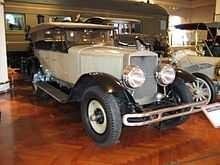
1924 Doble Model E
Steam-powered road vehicles, both cars and wagons, reached the peak of their development in the early 1930s with fast-steaming lightweight boilers and efficient engine designs. Internal combustion engines also developed greatly during WWI, becoming simpler to operate and more reliable. The development of the high-speed diesel engine from 1930 began to replace them for wagons, accelerated in the UK by tax changes making steam wagons uneconomic overnight. Although a few designers continued to advocate steam power, no significant developments in production steam cars took place after Doble in 1931.
** Post-WWII **
Whether steam cars will ever be reborn in later technological eras remains to be seen. Magazines such as Light Steam Power continued to describe them into the 1980s. The 1950s saw interest in steam-turbine cars powered by small nuclear reactors
this was also true of aircraft), but the dangers inherent in nuclear fission technology soon killed these ideas.
** Electric automobiles **
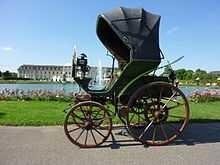
German Flocken Elektrowagen of 1888, regarded as the first electric car of the world.
In 1828, Ányos Jedlik, a Hungarian who invented an early type of electric motor, created a tiny model car powered by his new motor.[14] In 1834, Vermont blacksmith Thomas Davenport, the inventor of the first American DC electric motor, installed his motor in a small model car, which he operated on a short circular electrified track. In 1835, Professor Sibrandus Stratingh of Groningen, the Netherlands and his assistant Christopher Becker created a small-scale electrical car, powered by non-rechargeable primary cells.
1838, Scotsman Robert Davidson built an electric locomotive that attained a speed of 4 miles per hour (6 km/h). In England, a patent was granted in 1840 for the use of tracks as conductors of electric current, and similar American patents were issued to Lilley and Colten in 1847.
Sources point to different creations as the first electric car. Between 1832 and 1839 (the exact year is uncertain) Robert Anderson of Scotland invented a crude electric carriage, powered by non-rechargeable primary cells. In November 1881, French inventor Gustave Trouvé demonstrated a working three-wheeled car powered by electricity at the International Exposition of Electricity, Paris.[17] But others regard the Flocken Elektrowagen of 1888 by German inventor Andreas Flocken as the first true electric car.
Electric cars enjoyed popularity between the late 19th century and early 20th century, when electricity was among the preferred methods for automobile propulsion, providing a level of comfort and ease of operation that could not be achieved by the gasoline cars of the time. Advances in internal combustion technology, especially the electric starter, soon rendered this advantage moot; the greater range of gasoline cars, quicker refueling times, and growing petroleum infrastructure, along with the mass production of gasoline vehicles by companies such as the Ford Motor Company, which reduced prices of gasoline cars to less than half that of equivalent electric cars, led to a decline in the use of electric propulsion, effectively removing it from important markets such as the United States by the 1930s. However, in recent years, increased concerns over the environmental impact of gasoline cars, higher gasoline prices, improvements in battery technology, and the prospect of peak oil, have brought about renewed interest in electric cars, which are perceived to be more environmentally friendly and cheaper to maintain and run, despite high initial costs, after a failed reappearance in the late-1990s.
** Internal combustion engines **
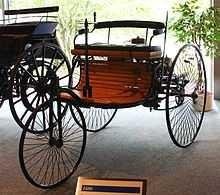
1885-built Benz Patent-Motorwagen, the first car to go into production with an internal combustion engine.
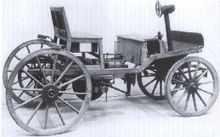
The second Marcus car of 1888 at the Technical Museum in Vienna.
Early attempts at making and using internal combustion engines were hampered by the lack of suitable fuels, particularly liquids, therefore the earliest engines used gas mixtures.
Early experimenters used gases. In 1806, Swiss engineer François Isaac de Rivaz built an engine powered by internal combustion of a hydrogen and oxygen mixture.In 1826, Englishman Samuel Brown tested his hydrogen-fuelled internal combustion engine by using it to propel a vehicle up Shooter's Hill in south-east London. Belgian-born Etienne Lenoir's Hippomobile with a hydrogen-gas-fuelled one-cylinder internal combustion engine made a test drive from Paris to Joinville-le-Pont in 1860, covering some nine kilometres in about three hours.[19] A later version was propelled by coal gas. A Delamare-Deboutteville vehicle was patented and trialled in 1884.
About 1870, in Vienna, Austria (then the Austro-Hungarian Empire), inventor Siegfried Marcus put a liquid-fuelled internal combustion engine on a simple handcart which made him the first man to propel a vehicle by means of gasoline. Today, this car is known as "the first Marcus car". In 1883, Marcus secured a German patent for a low-voltage ignition system of the magneto type; this was his only automotive patent. This design was used for all further engines, and the four-seat "second Marcus car" of 1888/89. This ignition, in conjunction with the "rotating-brush carburetor", made the second car's design very innovative. His second car is on display at the Technical Museum in Vienna. During his lifetime he was honored as the originator of the motorcar but his place in history was all but erased by the Nazis during World War II. Because Marcus was of Jewish descent, the Nazi propaganda office ordered his work to be destroyed, his name expunged from future textbooks, and his public memorials removed, giving credit instead to Karl Benz.
It is generally acknowledged that the first really practical automobiles with petrol/gasoline-powered internal combustion engines were completed almost simultaneously by several German inventors working independently: Karl Benz built his first automobile in 1885 in Mannheim. Benz was granted a patent for his automobile on 29 January 1886, and began the first production of automobiles in 1888, after Bertha Benz, his wife, had proved – with the first long-distance trip in August 1888, from Mannheim to Pforzheim and back – that the horseless coach was absolutely suitable for daily use. Since 2008 a Bertha Benz Memorial Route commemorates this event Soon after, Gottlieb Daimler and Wilhelm Maybach in Stuttgart in 1889 designed a vehicle from scratch to be an automobile, rather than a horse-drawn carriage fitted with an engine. They also are usually credited with invention of the first motorcycle in 1886, but Italy's Enrico Bernardi of the University of Padua, in 1882, patented a 0.024 horsepower (17.9 W) 122 cc (7.4 cu in) one-cylinder petrol motor, fitting it into his son's tricycle, making it at least a candidate for the first automobile and first motorcycle; Bernardi enlarged the tricycle in 1892 to carry two adults.
The first four-wheeled petrol-driven automobile in Britain was built in Walthamstow by Frederick Bremer in 1892.
Another was made in Birmingham in 1895 by Frederick William Lanchester, who also patented the disc brake. The first electric starter was installed on an Arnold, an adaptation of the Benz Velo, built in Kent between 1895 and 1898.
George F. Foss of Sherbrooke, Quebec built a single-cylinder gasoline car in 1896 which he drove for 4 years, ignoring city officials' warnings of arrest for his "mad antics.
In all the turmoil, many early pioneers are nearly forgotten. In 1891, John William Lambert built a three-wheeler in Ohio City, Ohio, which was destroyed in a fire the same year, while Henry Nadig constructed a four-wheeler in Allentown, Pennsylvania. It is likely they were not the only ones.
** Eras of invention **
** Veteran era **
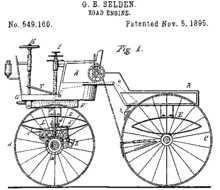
The Selden Road-Engine
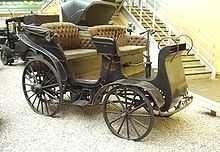
The Präsident automobile
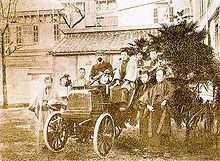
The first automobile in Japan, a French Panhard-Levassor, in 1898.
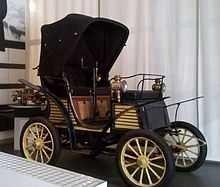
Fiat 4 HP, the first car model produced by Italian manufacturer Fiat (present-day FCA) in 1899.
The American George B. Selden filed for a patent on 8 May 1879. His application included not only the engine but its use in a 4-wheeled car. Selden filed a series of amendments to his application which stretched out the legal process, resulting in a delay of 16 years before the patent was granted on 5 November 1895 This patent did more to hinder than encourage development of autos in the United States. Selden licensed his patent to most major American automakers, collecting a fee on every car they produced.
The first production of automobiles was by Karl Benz in 1888 in Germany and, under license from Benz, in France by Emile Roger. There were numerous others, including tricycle builders Rudolf Egg, Edward Butler, and Léon Bollée. Bollée, using a 650 cc (40 cu in) engine of his own design, enabled his driver, Jamin, to average 45 kilometres per hour (28.0 mph) in the 1897 Paris-Tourville rally. By 1900, mass production of automobiles had begun in France and the United States.
The first company formed exclusively to build automobiles was Panhard et Levassor in France, which also introduced the first four-cylinder engine Formed in 1889, Panhard was quickly followed by Peugeot two years later. By the start of the 20th century, the automobile industry was beginning to take off in Western Europe, especially in France, where 30,204 were produced in 1903, representing 48.8% of world automobile production that year In the United States, brothers Charles and Frank Duryea founded the Duryea Motor Wagon Company in 1893, becoming the first American automobile manufacturing company. The Autocar Company, founded in 1897, established a number of innovations still in use and remains the oldest operating motor vehicle manufacturer in the United States. However, it was Ransom E. Olds and his Olds Motor Vehicle Company (later known as Oldsmobile) who would dominate this era with the introduction of the Oldsmobile Curved Dash. Its production line was running in 1901. The Thomas B. Jeffery Company developed the world's second mass-produced automobile, and 1,500 Ramblers were built and sold in its first year, representing one-sixth of all existing motorcars in the United States at the time.[27] Within a year, Cadillac (formed from the Henry Ford Company), Winton, and Ford were also producing cars in the thousands. The Studebaker brothers, having become the world's leading manufacturers of horse-drawn vehicles, made a transition to electric automobiles in 1902, and gasoline engines in 1904. They continued to build horse-drawn vehicles until 1919.
The first motor car in Central Europe was produced by the Austro-Hungarian company Nesselsdorfer Wagenbau (later renamed to Tatra in today's Czech Republic) in 1897, the Präsident automobil .